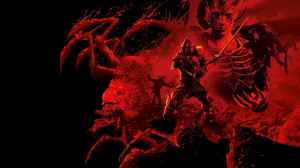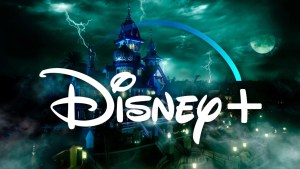Genre films have been a staple of the transitional state between being a kid and being an adult, as a number of genre projects use metaphorical storytelling to represent real-world fears. While it might not be a horror movie akin to The Conjuring or a release from Blumhouse Productions, writer/director Jane Schoenbrun’s I Saw the TV Glow offers audiences a dream-like experience that not only evokes those feelings of adolescent intrigue in spooky stories, but also grapples with complex themes surrounding gender identity, depression, and loneliness. I Saw the TV Glow opens in limited release on May 3rd and nationwide on May 17th.
Videos by ComicBook.com
Brigette Lundy-Pain stars in the film as Maddy, a teenager whose biggest obsession in life is The Pink Opaque, a supernatural mystery series that serves as a surrogate for the real-world Are You Afraid of the Dark? or Buffy the Vampire Slayer. When Maddy introduces Owen (Justice Smith) to The Pink Opaque, it becomes their only escape from the trauma of the real world, but when the series is unexpectedly cancelled, a mystery ignites that blurs the line between reality and fiction.
ComicBook.com caught up with Schoenbrun and Lundy-Paine to talk about the new film, the process of bringing it to life, and more.

ComicBook.com: Brigette, when you were growing up, what was your Pink Opaque? What was your thing that was your secret handshake with friends, a world that you could immerse yourself in? Also, if you could go back and tell that person growing up who had their Pink Opaque, what advice would you give to them now as an adult?
Brigette Lundy-Paine: Well, it’s funny I’m asked this question. I was not a super TV-obsessed kid, but I did, when I was in high school, I watched a couple of shows I loved a lot, and The O.C. was one of them. And I really was obsessed with Seth Cohen, Adam Brody’s character.
I think if I was going to go back and talk to myself I’d say, “Turn this off and start being quiet more and thinking, and stop hanging out with all these f-cking losers.” Just kidding. I loved my friends, but I also feel like I was really socially conformist, I think, in a way. When I was in high school, I was still super weird, but I was a cheerleader, and I was in leadership, and I think I was playing the social game in a way that, if I could tell my younger self, I’d just be like, “Stop this. You do not need to waste your time on this. Just take testosterone.”
Jane, it is clear that this is such a personal film for you, and I know so many audiences are going to connect with it. When you were making this film and you’re processing lots of different things, is the most therapeutic part of it the writing of the movie, the shooting of the movie, or releasing the movie and getting to engage with audiences and other viewers in its final form?
Jane Schoenbrun: Definitely not releasing the movie. That part, that’s what we have therapy for.
It is wonderful to share the movie and to see people have emotional reactions to the movie, but being in public with it and the promotion aspect of it is … I think I enjoy it in the sense that it’s fun to get on a bunch of calls that’ll be written up in public and do some sh-ttalking, but it’s definitely, the creative process is over by that point. And so, really, promotion feels like a different thing.
I think, especially for a film this personal, a film that, as an artist, is trying to speak authentically to an experience, it’s almost besides the point to try to then re-explain it. Being trans in public in 2024 is a very weird experience that I’ll probably make the next trauma thing about, so definitely not that phase.
I think that the writing process is when I’m really digging. Because my creative process that I’ve found that works for me is one where the thing that I’m writing is exploring, not so much trying to explain, but almost investigating whatever it is that I’m investigating, or working through, or dealing with in my real life. So, for instance, this film was written in the immediate aftermath of beginning transition, as my entire world and everything that I thought of as my home was being called into question while I was also running towards a future that felt exciting to me in a way that I had never done before. The movie is really trying to just, not so much tell you how that feels, but to create an authentic expression from within that experience.
I think it’s usually that part of the process that feels most purely, I don’t know that I would say therapeutic, but where I am most deeply engaging with the personal in a way that feels transformative. When you make a movie, that’s just fun. That’s just getting to play, hopefully, in a sandbox with a lot of other cool weirdos. Then when you finish a movie, when you edit it, that’s like you return to the first part of the process, but it’s much more about imagining how to fine-tune this thing so that the people watching it can have the deepest possible experience with it.
One scene that made me somewhat furious was the scene where you get to see Sloppy Jane and King Woman play in a tiny dive bar and I was furious thinking that I won’t get to see that happen anytime soon.
Schoenbrun: King Woman are playing Saint Vitus in a month or two, so come on out.
Well, I guess that leads into the soundtrack of the movie. What was the process of developing that? I know that you curated some playlists or some mix tapes for the artists that you spoke with about this film, and I wondered if those playlists or mix tapes had a common thread or common themes that popped up on everybody’s?
Schoenbrun: No, it was very targeted to each individual artist. I think the common thread, if there was one, was maybe working with contemporary artists and pulling origins out of them or something, or trying to find unexpected sounds, usually from the 1990s because that was the era that we were calling to with the soundtrack that could be interesting paths for them to explore, if they wanted to, as artists.
So, for instance, Frances Quinlan from the band Hop Along, writes a new song on the soundtrack. I remember sending her a lot of very trip-hop-influenced stuff. A lot of Portishead or Garbage, because I loved her sound and I thought it would sound really interesting to detour down in that direction a little bit.
But then it was a completely different process when I was on the phone with Drab Majesty and talking about Echo & the Bunnymen’s song from Sixteen Candles. I really did try to curate, in a handmade way for each artist, a direction that could be, if they wanted it, generative. I also really believe that the best style of curation, when you’re working with a pool of artists, is to create the structure and maybe even the spirit of the thing, and then let them interact with you as much as they want. Because a lot of artists will just want to go and have their process and that’s what’s going to produce the most personal and best work, so it’s always being very present and ready to roll up your sleeves and get involved, but also giving people a lot of space to make the cool things that they know how to make on their own.
In terms of curating and creating the soundtrack in general, it was there from the very beginning for me. It’s a movie that, in my opinion, existed in this lineage that felt so indebted to not only music, but also the soundtrack as a piece of media or art. I wanted to make a banger soundtrack. I wanted to make a teen angst soundtrack that could stand toe-to-toe with the best of them, so it was something I pitched A24 on when we were initially pitching A24. I said to them, “I want to make the best soundtrack since Garden State.” And, certainly, something that could be as generational a moment as the best soundtracks out there. Then it was just a matter of doing the incredibly fun work of choosing the artists and working with everyone to make the thing feel as — to imbue the thing with not the energy of a promotional document, but with the love of a mix tape.
Brigette, there are so many very intimate conversations that your character is having with Justice’s character, and then you have the powerful monologue toward the end of the movie. Was there a specific scene that you either looked forward to most in an “I can’t wait to bring this scene to life because of how much it specifically speaks with me personally” way or even a scene that you just knew, “As long as I nail this encounter, everything else is going to be smooth sailing,”?
Lundy-Paine: Definitely the monologue, because I think that was the second day we filmed. It was right up at the top. But I was happy for that because that was the thing I’d spent the most time preparing and it was bursting out of me. It was right on the brim of my consciousness for so long. Even when we started just walking through, Emma Portner choreographed the movements of it, and when they were walking me through the movements I could already feel it bubbling up. I just wanted to lock it down, because I knew it was about to spill. I knew that the whole movie was going to be in the monologue. I could understand the rest of the arc if I could do that.
Once we finished that, most of it felt really easy. I think I was precious with some of the scenes, like the bleacher scene. I remember feeling really nervous that it wouldn’t be right, because it felt like such a specific tone to have to strike. But yeah, I really trusted Jane and they were very generous with their reassurance through the process.
I Saw the TV Glow opens in limited release on May 3rd and nationwide on May 17th.
This interview has been edited for length and clarity. You can contact Patrick Cavanaugh directly on Twitter.








